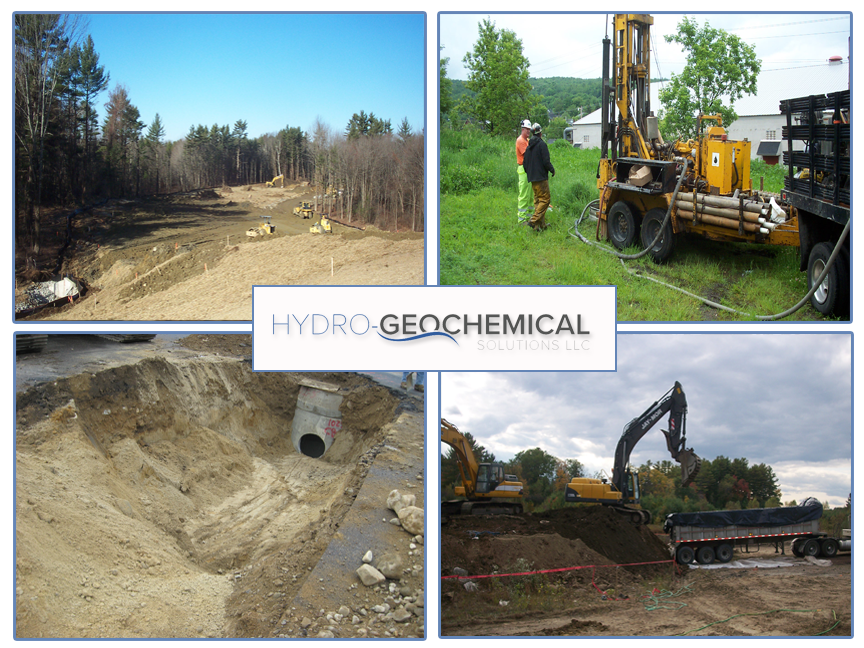
Hydrogeological & Contaminant Investigations
Extensive experience in performing hydrogeological and contaminant investigations at sites contaminated with non-aqueous phase liquids (NAPL), aromatic and chlorinated volatile organic compounds (VOCs), semi-volatile organic compounds (SVOCs) primarily polycyclic aromatic hydrocarbons (PAHs), metals, pesticides, herbicides, polychlorinated biphenyls (PCBs), and other hazardous substances. Investigative approaches have involved the use of intrusive and non-intrusive techniques to cost-effectively determine the type, severity and extent of contamination, and potential migration pathways. Hydro-GeoChemical’s expertise is used to develop concise and cost-effective investigative work scopes, focusing on client needs and regulatory requirements.
The key to completing a cost-effective and successful investigation is to a have a thorough understanding of the site, surrounding properties, and the presence, nature, and extent of contamination released to the environment (i.e., air, soil, soil-gas, groundwater, surface water, and sediment). This process begins with the development of a Conceptual Site Model (CSM), which is a written or illustrative representation of the physical, chemical, and biological processes that control the fate, transport, and migration of the contaminants, and the identification of potential receptors (i.e., human health or the environment). Hydro-GeoChemical has extensive experience in developing CSMs for small and large scale projects. For each project, the level of detail presented in the CSM corresponds to the complexity of the site and available data. The CSM is an iterative tool that is developed at the beginning of each project utilizing available information and is modified/revised as additional information is obtained during review of the site history and continues throughout the site investigation and remediation process. The CSM helps identify data deficiencies, and determines whether additional site characterization and/or remediation is required, or whether site closure has been achieved.
Hydro-GeoChemical is experienced in using a wide range of proven and innovative investigative techniques to obtain site characterization data, including but not limited to the following:
• Advancing soil borings and installing monitoring wells utilizing direct push, hollow stem auger, air-rotary, roto-sonic, and barber dual rotary drilling techniques.
• Excavating test pits.
• Collecting groundwater samples from monitoring points (monitoring wells, piezometers, and well points) using low-flow sampling techniques.
• Developing and implementing innovative drilling techniques (i.e., lead screened hollow stem augers) and on-site field analysis of groundwater samples with a portable field gas chromatograph (GC).
• Using Membrane Interface Probe (MIP) to delineate non-aqueous phase liquids in the subsurface soil.
• Mapping site features using survey equipment.
• Using portable field equipment for field screening (photoionization and flame ionization detectors, landfill gas meters, explosimeters, %O2-LEL gas meters, and gas chromatography).
• Developing and implementing a field screening program using immunoassay analysis (PCBs and PAHs).
• Conducting soil-gas and indoor air sampling surveys.
• Performing dye testing and camera surveys to assess underground utilities.
• Evaluating aquifer characteristics with short and long-term aquifer tests, and single well recovery tests (slug tests).
• Performing geophysical surveys (ground-penetrating radar, magnetometer, electromagnetic, and seismic refraction) to identify aquifer thickness, bedrock surface, and subsurface structures and features.
• Mapping non-aqueous phase liquids and contaminant plumes.
• Collecting surface water and sediment samples.
• Conducting rock coring, fracture trace analysis, and borehole geophysics (gamma ray, caliper, resistivity, spontaneous potential, neutron-density, porosity, and temperature).
• Using computer modeling to evaluate hydrogeologic conditions and contaminant plume characteristics.